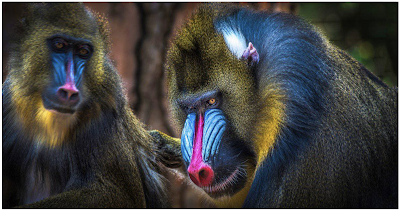A lil' 90s throwback
The more things change, the more things stay the same...
One of the items that is most interesting to me in evolution is sexual selection. The extremes that some organisms will go to and the adaptations made simply for reproduction that would otherwise be detrimental are so intriguing to me. The male fiddler crabs, whose oversized claw can be half their body size, don't really use this claw for anything outside of attracting a mate a digging a burrow. The bright colors of birds will almost always put the boring red, yellow, brown, and black pigments of mammals to shame; with the exception of the Mandrill whose vibrant coloring is indicative of their reproductive success.
Though complex thought and free will are considered some of the hallmarks of humanity, I love taking a look at some of the pieces of evidence that show how little control humans have over who we choose as our sexual partners. We like to believe that our choice in mate is a series of calculations and unique situations, but after viewing The Science of Sex Appeal, my position was reframed.
More than Just a Pretty Face
One of the first characteristics we notice about someone is their face and the orientation of their facial structures. Some of the simple examples of this are when you notice that a person's eyes are slightly farther apart than what seems "normal." This is called the "Golden Ratio." The Golden ratio, related to the Fibbonacci sequence, creates a predictable pattern of what we find attractive. The following video has you try a little "Brain Game" to see if your results end up being the same as the participants.
More than just the Golden Ratio, facial symmetry also plays an important role in sexual selection for humans. Slight abnormalities or illnesses during fetal development can cause a slight shift in the structures of the face. This slight asymmetry might signal poor health or genetic weaknesses. The proof is in the pudding: Look at the two images below and determine which one you gauge as more or less attractive.
(a) is the original image, whereas (b) has been changed to amplify the amount of asymmetry in the image. Most people agree that the image on the left is more attractive than the image on the right.
Not only does the level of symmetry in a face impact it's attractiveness, but we can also determine an individual's hormone levels by simply looking at their face! In the same article as above, composites of males and females were made and then masculinized and feminized to determine if participants showed a preference for either composite. Which images do you find more attractive?
The composites on the left have been masculinized, producing more angular changes in the jaw and hairline. The composites on the right have been made more feminine with softer angles in the jaw and hair, as well as thinner eyebrows. Most individuals find the female (top) on the right and the male (bottom) on the left more attractive.
But Wait, There's More!
About 50,000 years ago, humanity went through a bottleneck event that almost ended our species. For that reason, humans are more similar to each other than virtually any other primate, especially as human populations travelled further from Africa. This lack of diversity makes the chances of inadvertent inbreeding very risky, so the ability to smell individuals who are more genetically similar to you would be an evolutionary advantage. If you reproduce with someone who has a complimentary major histocompatibility complex (MHC), then the chances of your children having a wider immune response is greater. Women seem to find the scent of individuals who are not closely related to them less repulsive, and even pleasant near ovulation.
Say what?
At the dawn of civilization, the selection of mates would have frequently been done around a fire, or during times when a person's facial features were masked. What's left is the sound of their voice. What may be surprising is the level of impact that voices have on whether we find someone attractive. In speaking with Hazda tribal communities, researchers found that the men with the deepest voices were also those who were most likely to have the highest number of children.
As a result, additional studies have been done that show men also have a preference for higher pitched voices in women. Even more interesting to me is that the women's voices changed throughout their menstrual cycle.
And Everything Falls into Place...
Each of these situations gives men, but more so, women, a glimpse into the biological health of their potential partners. We like to say that everyone has different preferences, but the evidence seems to contradict that premise. A symmetrical face indicates healthy development; testosterone and estrogen give visual cues as to how much of each hormone you received during puberty; scent helps maintain incest avoidance, and; voice gives another clue as to a male's testosterone level, as well as a female's fertility. These buried drives steer us toward the most desirable partner we can snag, and we have much less control over the choices we make than most would like to believe.
I guess we're not so different from our Mandrill cousins.


